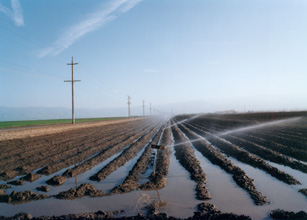El Valley Centro
James Benning
USA 1999 |
| |
|
 |
|
|
|
|
|
|
Produktion: James Benning
Weltvertrieb: James Benning
24700 Mc Bean Parkway, Valencia,
CA 91355, USA
Tel.: (1-661) 253 7825, Fax: 253 7824
e-mail: jbenning@muse.calarts.edu
Kamera, Ton, Schnitt: James Benning
Format: 16mm, Farbe
Länge: 90 Minuten, 24 Bilder/Sek. |
|
|
|
| Die Arbeiten von James Benning sind ‘pretty
much avant-garde’, doch im Verlauf seiner mittlerweile drei Jahrzehnte
währenden Karriere hat sich der amerikanische Filmemacher zu einer
Art strukturalistischem Dokumentaristen entwickelt, der mit immer bescheideneren
formalen Mitteln sein Auslangen findet... El Valley Centro beispielsweise
bezeichnet er selbst als ein „Ton-Bild- Porträt“. Der Film,
gedreht im kalifornischen Great Central Valley, besteht aus exakt 35 Einstellungen
zu exakt 2 Minuten und 30 Sekunden. Es gibt weder Kamerabewegungen noch
Kommentar; der Ton wurde direkt, also immer vor Ort aufgenommen. Die Blickachse
verläuft in der Regel entweder parallel oder frontal zum Geschehen.
Am Ende des Films folgt eine Reihe von Titeln, die Aufschluss über
den genauen Drehort und die Besitzverhältnisse des jeweiligen Landstriches
geben; und auch diese ‘Einstellung’ ist exakt 2 Minuten und 30
Sekunden lang... Im Falle von El Valley Centro, so Benning, habe sich die
Struktur des Films aus ein paar einfachen arithmetischen Spielereien ergeben:
„Ich habe 16-mm-Rollen mit einer Länge von 100 Fuß verwendet,
das entspricht 2 Minuten und 47 Sekunden Film. Nachdem ich ein bisschen
herumgerechnet habe, bin ich auf diese Szenen von zweieinhalb Minuten und
einen Film von genau 90 Minuten gekommen. Die Idee, dass man so ein neues
Maß für gewisse Dinge bekommen würde, hat mir einfach zugesagt.“
Benning ist kein Landschaftsmaler, zumindest nicht im klassischen Sinn eines
Albert Bierstadt oder John Ford. Sein Interesse gilt der „politischen
Geographie“, dem „Zusammenstoß von amerikanischer Landschaft
und menschlicher Präsenz, die sie endlos verändert, neu erschafft,
produziert und verschmutzt“, wie es die Filmtheoretikerin Bérénice
Reynaud einmal formulierte. Michael Omasta |
| |
|
|
James Benning’s work may be pretty much
avant-garde, but in the course of his now
three decade-long career he has become
something of a structuralist documentary
filmmaker who achieves his aims by increasingly
modest formal means. For in-stance,
he himself describes El Valley Centro
as an “audiovisual portrait.“ The film, shot
in California’s Great Central Valley, consists
of exactly 35 shots, each exactly two minutes
and 30 seconds long. There is neither
commentary nor camera movement. The
sound was recorded directly, i.e. always on
location. The imaginary line of each shot
runs either parallel to or towards the centre
of attention. At the end of the film, a
number of intertitles give information
about where each landscape is and who
owns it. This “shot“ too is exactly two minutes
and 30 seconds long...
Benning says the structure of El Valley
Centro was the outcome of a few simple
arithmetical considerations. “I used 100-
foot reels of 16mm film,“ he says. “That’s
two minutes and 47 seconds of film. After
I played around with the numbers a bit, I
had the idea of scenes lasting two-and-a-half
minutes and a film lasting exactly 90
minutes. I just liked the idea that certain
things would thus be given a new frame of
reference. It is the time it takes a rodeo
champion to tie up three goats, a cottonpicker
to traverse half a field and an empty
goods train to pass straight through the
shot.“ ... Benning is no landscape artist, at
least not in the classical sense of an Albert
Bierstadt or John Ford. Rather, he is interested
in “political geography,“ the „clash
between American landscape and a human
presence that constantly changes, recreates,
reproduces and pollutes it,“ as film
theoretician Bérénice Reynaud once put it.
Michael Omasta
|
| |
|
|
